Wallace’s flying frogs, also known as gliding frogs or Abah River flying frogs are a type of moss frog and are known for their photogenic appearances and dramatic behaviour. Due to their charming appearance, Wallace’s flying frogs often capture the hearts of amphibian lovers who desire to keep them as pets. But are Wallace’s flying frogs good pets for beginners or families? Let’s find out.
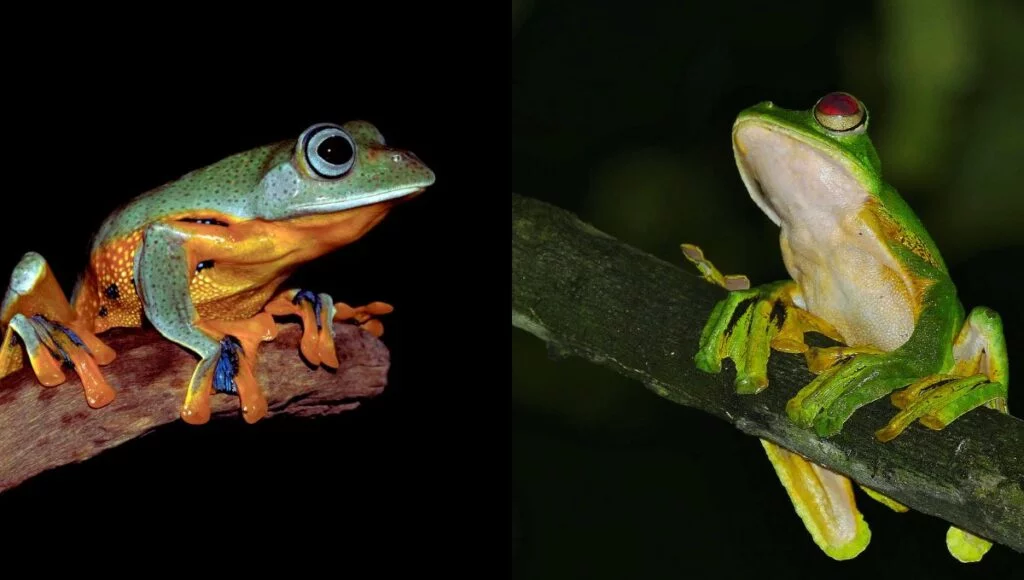
Table of Contents
Everything About Wallace’s Flying Frogs:
In a Glimpse:
| Common Name | Wallace’s Flying Frogs |
| Scientific Name | Rhacophorus nigropalmatus |
| Other Names | Gliding frogs, Abah River flying frog |
| Maximum Length | 3.1-4 inches |
| Maximum Weight | N/A |
| Ranges | Asia |
| Habitat | Lukewarm and moist wetlands |
| Diet | Carnivore |
| IUCN Status | Least Concern |
| Lifespan | 4-8 years |
Geographical Range:
These flying frogs are usually found in the Malay Peninsula in western Indonesia, including Borneo and Sumatra. Similar frog species are also found in Laos, Malaysia, Thailand, Vietnam, and Southern China.
Habitat:
Wallace’s Flying Frog is mainly native to Indonesia which lies on the equator and thus they prefer to stay in a warm but very humid environment. Due to heavy rainfall in that region, the frogs can’t survive in a dry environment. Tropical moist evergreen forests are their preferred habitat to live in. Tall trees, palm trees, bushes, and similar plants are often their home, and the flying frogs are found 700-1800 meters above sea level.
Physical Descriptions:
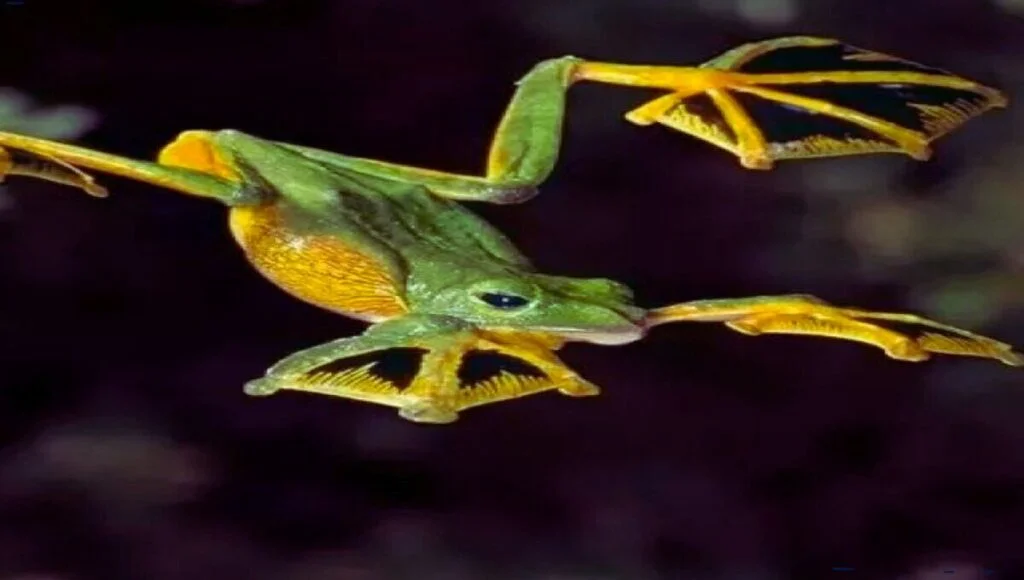
These flying frogs are one of the largest species of Rhacophorus, a genus of frogs. Large eardrums, large eyes with horizontal pupils, long veins, and fully webbed fingers and toes help them fly and parachute to the forest floor from high trees.
Wallace’s flying frogs have bright shiny green back with white to pale yellow abdomen. Their fully webbed toes are yellow and one part of each side is jet black. The flying frogs are a bigger version of green flying frogs that share a similar geographic range and habitat such as Wallace’s flying frogs.
Sexual dimorphism is present in these flying frogs as the females are larger than males. Apart from size, there is not much visible difference is present between the two sexes. The average snout-to-vent length of an adult frog is 3.1-4 inches (8-10 cm).
Defence Mechanism: Are Wallace’s flying frogs poisonous?
No, Wallace’s flying frogs are not poisonous at all as they don’t secrete any kind of toxic chemicals from their skin. However, when threatened, they just leap and fly from tree to tree or bush to avoid predators.
Behaviour:
Wallace’s flying frogs are arboreal, solitary, and nocturnal by nature. Unlike other arboreal frogs, they can leap from tall trees and branches and spread their four webbed feet. The loose membrane between their toes and loose skin flaps on their sides as parachute and catch the air as they fall. This feature allows them to glide more than 50 feet (15 meters) between trees or even to the ground. Their big toepad and tiny suction pads on their feet and toes also help them to land on the ground softly without any injury and also stick to the tree trunks.
Breeding Behaviour:
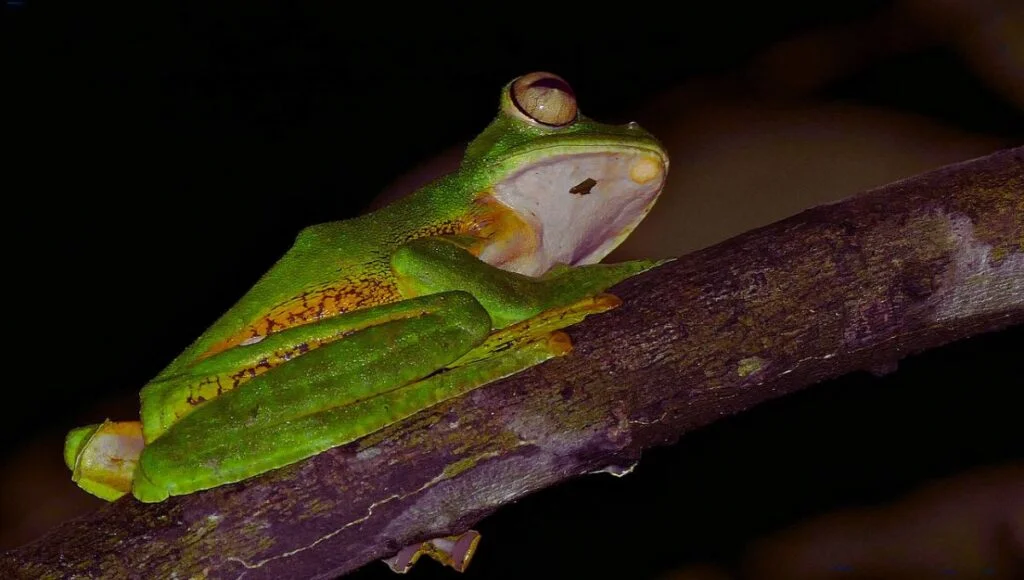
These flying frogs prefer shallow water such as ponds, marshes, temporary lakes, etc as their breeding habitat because in still water females can create a bubble nest on a branch or foliage above the water source by lashing fluids they produce and beat into a foam with their hind legs. After the female lays her eggs, the male fertilizes them with its sperm.
When the eggs hatch, tadpoles develop and fall into the water below. In the water, the tadpoles develop and undergo metamorphosis into juvenile frogs. Juvenile frogs are red with white spots on their abdomen and after reaching their sexual maturity (approximately a year), the adults turn into green colour. The adult frogs live only in trees, they come to the ground only for breeding.
Aggressiveness:
Wallace’s flying frogs are not aggressive to humans. Instead, they are shy and often try to avoid confrontation with humans. These flying frogs even don’t bite or secrete any chemical to defend themselves from humans. They only use gliding techniques to avoid the grip and escape from humans.
Diet:
Wallace’s flying frogs or gliding frogs are carnivorous by nature. They consume any insects, worms, flies, etc that fit into their mouth. Spiders, cockroaches, other small frogs, smaller birds, and small snakes are their main source of diet.
Predators:
The flying frogs are excellent at jumping and gliding and hence they are very difficult to catch. Additionally, their arboreal nature and camouflaging ability help them to avoid predators. Tree-climbing snakes, larger prey birds, and bigger frogs are Wallace’s tree frogs’ main predators.
Conservation Status:
The frog species are listed as Abah River Flying Frog in the IUCN Red List of Threatened Species as “Least Concerned”. But it is also mentioned that the population of mature individuals is decreasing in the wild.
Lifespan:
How long Wallace’s flying frogs live in the wild and captivity is unknown. However, some sources claim these frogs live 4-8 years in the wild.
Are Wallace’s flying frogs (gliding frogs) good pets?
Wallace’s flying frogs are very unique and different choice as pets. The gliding frogs require a certain environment to survive and as a pet owner, you need to provide them with their native environment at your home. Due to their arboreal and gliding nature, they often try to escape the enclosure, so you need to be very careful.
The gliding frogs are very shy and not aggressive towards humans. They avoid confrontation with humans but they don’t harm humans if you touch and care for them. The frogs are neither noisy nor very difficult to maintain once you set up their habitat and preferred environment. If you have previous experience of maintaining frog species, this species might suit you.
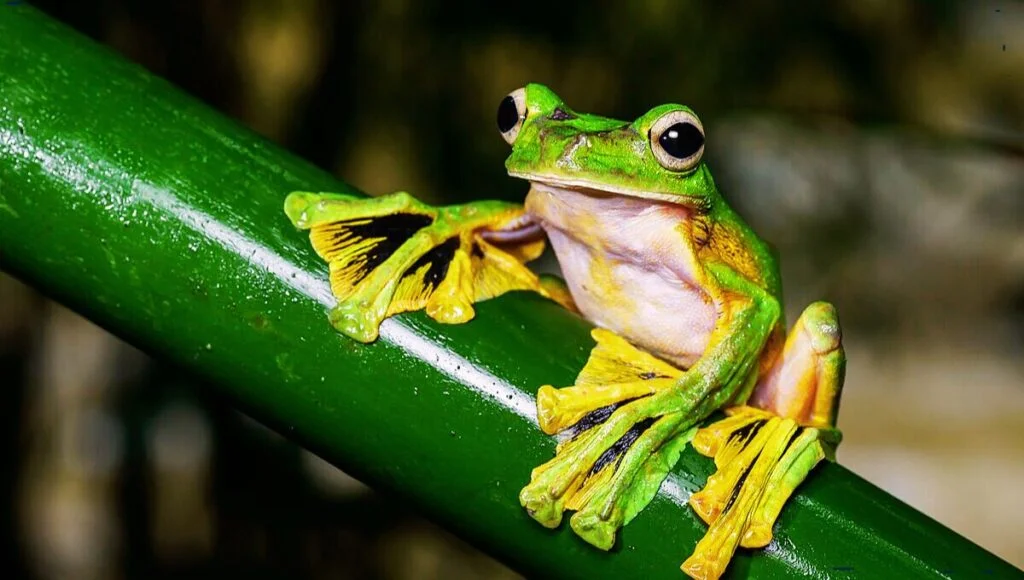
You can watch their movements such as gliding, jumping, and flying, and enjoy these activities if you have a transparent tank. They often jump from one to another trees for safety and food and being an owner, you can enjoy them.
However, you need to be cautious about their health as it is studied that gliding frogs are often attacked by parasites. Once a day, check their body if you can trace evidence of a parasite attack.
Another big problem is that these frogs are not easily available in the pet market and thus people often buy unhealthy gliding frogs caught in the wild. If you can find a captive-bred Wallace’s flying frog then it can be a good pet for you as it is very attractive by appearance, photogenic, entertaining, low maintenance, and easy to care for.
How do you buy a Wallace’s flying frog or gliding frog?
Gliding frogs are very difficult to find in the pet market. You can only often find the illegally caught frogs from the wild that are unhealthy. Hence, it is advised to stay away from illegally caught frogs. You try to purchase the frogs from a reputed breeder or pet shop. However, you can check online platforms if you can avail them at a cheaper price. However, always ask for proof of origin, health conditions, and other information before buying. Also, while checking online platforms, check their reviews, policies, and other important information very carefully.
The price of Wallace’s flying frog will depend on its size, sex, and availability. However, you may expect to pay at least $65 for the frog species as many frog lovers want to keep them as pets but the supply of healthy gliding frogs is very limited in the pet market.
Requirement and Care:
Enclosure:
Despite being not so big, Wallace’s flying frogs require a very large container so they can fly and glide from one tree to another. The bigger is the better, but if you lack space, you at least need a 75-gallon tank with sufficient height to create their native environment.
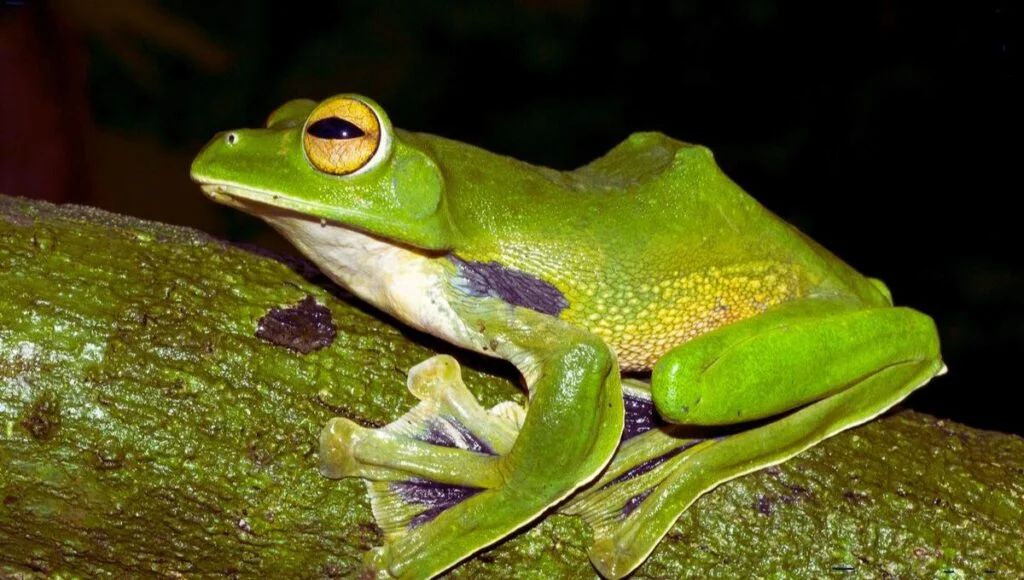
You also need to plant some tall trees that allow the frogs to fly or glide. We suggest using artificial plants inside the enclosure instead of live plants as they are easy to clean, don’t generate wastage, and also roots don’t harm the frogs while burrowing. As these frogs breed and the tadpoles develop in the water, 50-70% of the container must be filled with water and the rest will be land area.
Being an arboreal frog, gliding frogs often tend to escape the enclosure by gliding, hence use a tight lid with a proper ventilation system that will help to maintain the humidity. Also, use a transparent tank that is eco-friendly and doesn’t harm the frog’s skin. A transparent tank will allow you to maintain the frog’s activity such as gliding, flying, and hunting.
Substrate:
Any substrate that mimics their natural habitat and can hold the moisture level, is suitable for gliding frogs. You can use coco fibre, sphagnum moss, or their mixture along with some soil as substrate. If you plant artificial trees, then you can also use artificial substrates which is equally good. Additionally, a thick layer of leaf litter can provide an extra level of moisture and will also help the frogs to land on the ground while jumping from the trees.
Temperature and Humidity:
Wallace’s flying frogs require a lukewarm and humid environment to thrive. You must maintain the temperature between 65°F and 70°F at daytime and a little cooler at night. Any temperature beyond 75-80°F is dangerous for gliding frogs. Additionally, you need to maintain the humidity at 80-100% because, without high humidity, neither the adults nor the tadpoles can survive.
You can use a digital thermometer and hygrometer to monitor the temperature and humidity level. If the enclosure is cold enough use a heat lamp or heat mat to warm it up. But remember if the temperature of the enclosure is more than 80°F, it is very difficult to cool it down. Hence, keep the enclosure in the coldest part of your house to maintain the temperature. You can use a fogger or mist maker in order to maintain the humidity level. Or you can simply just sprinkle water several times a day to maintain the required humidity level.
Light:
Like any other amphibian, gliding frogs need a 12-hour day-night circle to regulate their daily activities. You can use a low-wattage UVA/UVB bulb to provide them with proper lights. The UVA/UVB lights will also help the frogs get a sufficient amount of vitamin D that they don’t get from the sunlight.
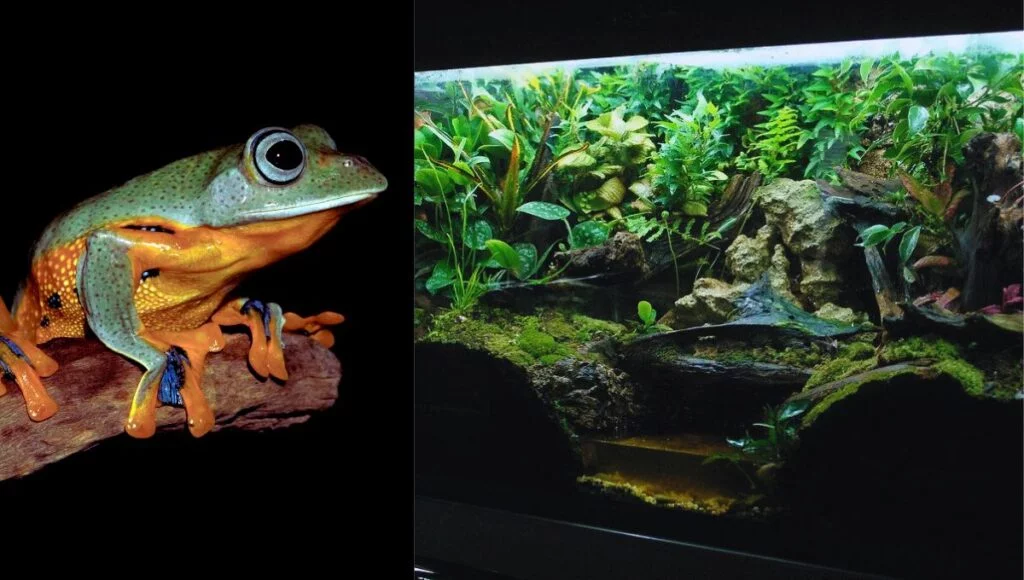
Food and Water:
Wallace’s flying frogs are completely carnivorous and the amount of food they require depends on their size, age, health conditions, and appetite level. Due to living in a cooler environment than other frogs, their digestive system is much slower.
If you feed an adult three to five gut-loaded crickets every three days it’ll be sufficient for them and also prevent obesity. You can also feed them with gut-loaded wax worms, mealworms, super worms, cockroaches, etc. Once in 14 days dust their food with calcium and vitamin supplements to provide them with proper nutrition and micro-nutrients. But you need to feed the tadpoles every day.
You must provide them with a sufficient amount of dechlorinated water which is free of pollutants. You can also provide them with rainwater, which is collected directly after 30 minutes after the rain starts. You must change 50% of the water daily and again fill the tank with fresh water. As their skins can absorb the water, ensure the water you provide is fresh, pollution-free, and dechlorinated.
Cleaning:
You need to clean waste food, dead insects, and water dishes regularly to prevent any kind of bacterial and fungal growth. As Wallace’s flying frogs are often attacked by parasites, you need to pay special attention after cleaning. Additionally, deep clean the tank once a month with a mild disinfectant and rinse thoroughly with dechlorinated water. Change substrate only if it smells bad or necessary.
Handling:
Gliding frogs are very shy and often try to avoid humans. But if you touch them and care to a certain extent, they won’t oppose you. But unnecessary and careless touches can make them stressed. Hence, it is advised to touch them only if necessary, otherwise let them enjoy their own company.
With proper care and attention, Wallace’s flying frogs or gliding frogs can live up to 8 years. Hence, try to respect your frog’s personal space and choices.
FAQs:
Can you keep two or more Wallace’s flying frogs (gliding frogs) in the same tank?
It is advised not to keep two gliding frogs in the same tank because these frogs are solitary and require a lot of space to thrive. Gliding frogs are not very large species of frogs but they require a huge amount of space to perform physical activity, such as flying, gliding, leaping, etc. It is still unknown if these flying frogs show cannibalistic behaviour and thus for safety reasons, don’t put two or more flying frogs in the same tank.
Reference: Wallace’s Flying Frog from Wikipedia
Also Read: Are Carpenter Frogs Suitable Pets For Beginners? A Perfect Pet Guide
Also Read: Are Vietnamese Mossy Frogs Good Pets? Your Perfect Pet Guide